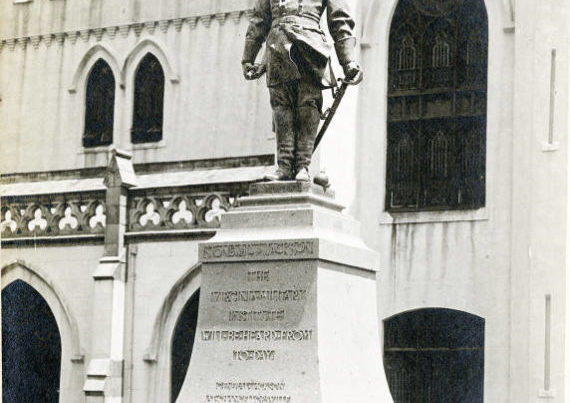
When Robert E. Lee died in 1870, a memorial association was formed in the City of New Orleans. After six years had passed, the association raised an amazing $36,400 – during the throes of Reconstruction – to construct a monument. The world-famous New York-based sculptor Alexander Doyle (who studied in Bergamo, Rome, and Florence) was commissioned, and it was installed at Tivoli Circle – renamed Lee Circle – in 1884. The statue was placed atop a granite pedestal consisting of a 60 foot column. The statue itself is 16.5 feet high and made of bronze. Attendees at the dedication included Jefferson Davis, two daughters of General Lee, and former Confederate general P.G.T. Beauregard.
Monuments such as these also memorialized the many common soldiers whose bodies were never recovered for burial, or who lie strewn across battlefields in unknown, unmarked, or even mass graves. The postwar monuments provided solace for survivors and healing between the regions as monuments to the dead of both sides in the war were erected as the veterans were dying off. The Lee statue was a rare early monument erected during the post-war federal occupation of Louisiana.
In time, Lee Circle and the monument became an important landmark and meeting point for locals, especially for Mardi Gras parades. The Circle stands at basically the intersection of the Garden District, the French Quarter, and the Central Business District. The statue became iconic to the landscape of the city. The monument made the National Register in 1991, and in 2011, New Orleans Magazine declared it one of the most important statues in the city (along with another striking Doyle piece, the equestrian statue of P.G.T. Beauregard).
Six years later, after 133 years, the monument was declared “racist” and removed, being placed in a shed in a city junkyard where it remains – along with three other historical monuments (including Doyle’s Beauregard) hidden to this day.
The column remains in place with nothing on it.
On January 22, 2022, a new statue was erected at the ground level of the pedestal where it will remain for several months. It was executed by another New York sculptor named Simone Leigh. The statue is entitled “Sentinel (Mami Wata)” and it “takes the diversity of African cultures in New Orleans as a starting point, evoking African folklore and spiritualities.” The statue is supposedly an African idol, described as a “water spirit or deity.” The deity is sometimes associated with lust and prostitution. This representation is a nude female form wrapped by a snake with the unique and unusual element of having a head shaped like a spoon.
Yes, a spoon:
“The ceremonial spoon form of the sculpture references a symbol of status in Zulu culture, so honored in New Orleans,” according to the exhibition. “Leigh’s sculpture holds forms of knowledge that have been passed down through spiritual and masking traditions of the city and beyond, wherein masking signifies transformation, not simply concealment.”
Rather than locate it on the top of the sixty foot pedestal, it sits on the ground. It is claimed that this was intentional:
“Not looming over people but rather emerging from among us,” the exhibition statement said. “This constellation de-centers whiteness and the legacies of colonialism, renewing access to knowledge and culture that has been suppressed by the falsehoods of white supremacy.”
Of course, that may just be a flowery way of saying that they lacked the know-how and the money to hoist it to the top of the six-story column.
At any rate, this is a fitting symbol of New New Orleans: a crime-ridden, violent, impoverished, drug-invested, culturally-debased, infrastructure-ruined, politically-destroyed and corrupted city, a shell of its former historical greatness. The naked woman with the head of a spoon is wrapped by a serpent, calling to mind Eve and the original sin of mankind, a primitive hot-mess of a superstitious idol, representing the decay of civilization, culture, art, history, and craftsmanship.
This is a fitting display of public art that fits in with the city’s other offerings, such as electrical boxes painted in what appears to be finger paint, often with depictions that look like stick figures, or a large scrap-heap of junk bicycles painted white and piled on one another, and murals that are indistinguishable from the seedy graffiti and rat-infested blight that dot the landscape where majestic statues once stood in manicured public spaces.






Lee lost because he was a gentleman. Lee’s statue was lost because the people who placed the statue did not learn from Lee’s defeat.
Own the property. The ignorant can wail and gnash their teeth. There will always be useful idiots to support tyrants. Do not believe since you cannot tolerate the thought of total war that your opponent will not embrace burning your cities to the ground and starving your women and children.
May 1863, Jackson, Mississippi becomes “Chimneyville”.
27 June, 1863, General order 73. “The commanding general considers that no greater disgrace could befall the army, and through it our whole people, than the perpetration of the barbarous outrages upon the unarmed, and defenceless and the wanton destruction of private property that have marked the course of the enemy in our own country.”
In reference to Mr. WQPIII, first of all the loss of the War was hardly due to Lee alone. And to imply (par. 2, sent. 3) that the Confederacy should have aped in totality the methods of the North is to say that we should also have become like them morally. Who in his right mind would want to be a Sherman, a Sheridan, a Butler, and a host of others?
Arguably we did need more N. B. Forrests or a more expeditious employment of the one we had. We needed a more comprehensive strategy that accounted for the vital importance of the western campaign, we needed more men and money and materials, on and on. So much went wrong and was not compensated for by what went right.
But all that aside, the statue (if that is what it is) that has replaced the Lee statue is in one respect utterly sad, pathetic. But then the Rev. Beane has a quite valid point: it is a fitting display of public art in a city that has lost its way. The two truly deserve one another. The rest of us deserve better.
I believe Lee would have said, “I lost the war”. In fact, I cannot imagine a world in which Lee would not take the blame, solely…and soulfully.
Jackson said we should have flown the black flag. I believe Jackson. Lee believed Jackson.
God bless us all.
Indeed, the General would take the blame, God bless him. He took it after Gettysburg. Unfairly, it seems to me. But there it is.
And as you say, God bless us all.
I appreciate your candidness regarding what has happened in New Orleans. This piece you’ve written is a snippet of what is happening across this country. The addition of a Mami Wata statue is crude and disgusting. It stands for despicable demonology, child sacrifice and deplorable sexuality. Thank you for documenting.
Amen.